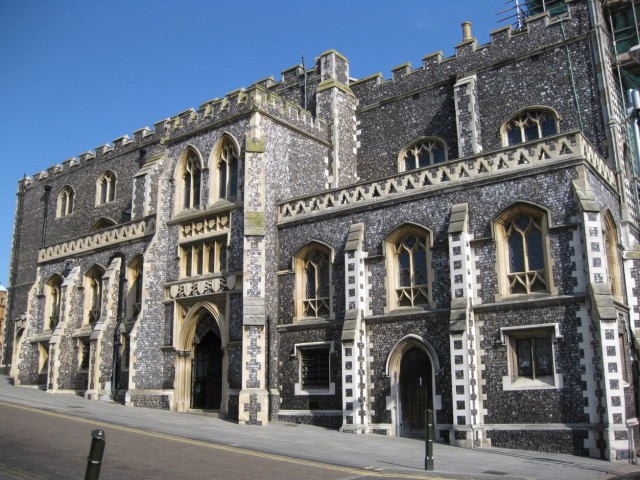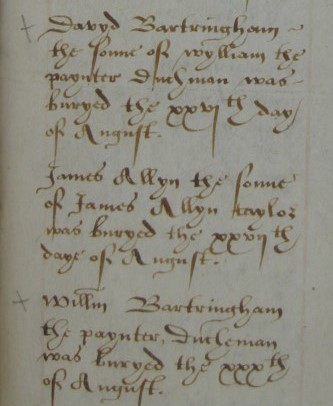People are supposed to learn from history, so it is interesting to compare the present situation with a similar, or even more calamitous, happening in Norwich’s past. This is the plague, which first came to Norwich in 1349 (that first outbreak usually known as the Black Death) and then continued to exist in waves over three hundred years. At first people thought there was little they could do except pray, but over the centuries some practical measures came to be adopted, and these were remarkably like the kind of measures adopted in 2020. I am looking especially at those adopted between 1579 and 1666 (which turned out to be the final year of plague). The Privy Council (the Tudor equivalent of today’s Cabinet) laid down general ‘Orders’, but it was up to local authorities to decide how and when to apply them.
The city was run by an Assembly consisting of aldermen and common council, but the day-to-day running was in the hands of the aldermen in the Mayor’s Court. There were twenty-four aldermen (and of course they were all men), two for each ward in the city. Once elected, a man would serve for the rest of his life, so that the same man might remain aldermen for ten, twenty years or even longer: you would know your aldermen, and the alderman would know what was going on within his ward. The Mayors’ Court met every Wednesday and Saturday, and it was this body that decided what regulations were to apply and when, and decided when it was the right time to ease them.

Norwich Guildhall: the Norwich aldermen met here twice a week and decided on regulations during a time of plague.
One obvious step was to try to keep the plague out. The city had the means to enforce a lockdown. In those days almost everyone lived within the area surrounded by city walls and there were only a limited number of gates through which people could enter or leave. These could be closed, or a check could be made on anyone coming in or out. For example, in 1625 the gatekeepers were ordered to refuse entry to people from London and Yarmouth, plague having broken out in both places. During the 1665-6 outbreak, a chain was put across the river at the boom towers (near the present-day football ground) and a boat was manned day and night to check on people coming from Yarmouth by river: only those with certificates of health were allowed to come into the city.
In 1631, when there was plague in Wymondham, people coming from there had to produce certificates saying they came from uninfected houses. One Wymondham butcher was found to have forged his certificate, but three others were allowed to sell their meat on Norwich Market. Even then, a watchman stood beside each of the stalls warning people that the man came from Wymondham, customers presumably making their own judgements as to the risk.
In the 1666 outbreak, the Market was actually moved out of the city to the large open space known as Town Close: this was presumably to facilitate social distancing among traders and their customers, and meant that traders from the country did not have to come into the crowded city.
Isolation was the main weapon against the spread of plague. If a case of plague was discovered, the whole house was boarded up and marked with a sign to warn others not to enter. Those inside would have to remain until the danger of infection had passed after the victim had died or recovered. This time span seems to have varied: a month according to the 1579 Orders, six weeks according to those issued in the 1630s. Of course, if another householder came down with the plague during that time, then the lockdown of that house would be extended: there are cases of people staying in this form of isolation for much longer periods as one family member after another came down with the disease. In 1579, it was ordered that the houses with plague victims should be marked with the dramatic words: ‘LORD HAVE MERCY UPON US’. By the 1630s, the Orders just insisted on some special mark being placed on the doors.

Burial register, St Michael at Plea 1579. Causes of death are not given but the burials of William Bartringham and his son within four days strongly suggest plague – especially as two of William’s daughters were buried within a very short time. (Norfolk Record Office, PD 66/1)
In some ways, this isolation would be even more difficult than today: the house would, of course, have no fridge or freezer to preserve food – and no running water. The city took on the responsibility of supplying those in self-isolation, paying someone to supply food and drink to the infected house. These people were known as ‘keepers’. Watchers might also be appointed to make sure nobody left the house.
For those who could not, or would not, maintain this form of family self-isolation there were pest houses. These were on Butter Hills (then open ground where Bracondale meets Ber St). People were appointed to provide food and water to those in the pesthouses – and watchmen to make sure that people did not try to escape.
A job even more dangerous than being a keeper was to be a searcher. During times of plague, these were appointed to search or view the body of anyone who died to see if they had died of plague. These people had no special qualifications and there was no question of any autopsy: I imagine they simply looked at the body to see if there were obvious signs like the buboes or swellings under the armpits or in the groin characteristic of plague victims. It can be questioned as to how accurate such a system was, but it was a lot better than nothing, giving the city authorities some idea of the extent of the plague. Of course, to be a searcher or a keeper was very risky: they would be expected to self-isolate. If they did have to go out, they were ordered to carry a visible sign – a wand two foot long – so that people could know them and apply social distancing.
By Frank Meeres














Thank you for the interesting read, Frank! (We met a few years ago now on one of you 1000 years of Architecture/Norwich 12 courses). Best Wishes to you & yours.
LikeLike
What an interesting article. Instead of complaining about what an inconvenience lockdown is, we might consider what a blessing it is to have running water, fridges and online shopping! Thank you for sharing this, we’ve come such a long way in many ways and not so far in others.i expect the same sense of disbelief existed then as it does now.
LikeLike
Thanks Linda. We’re glad you enjoyed the post. Look out for a further post from Frank Meeres about how the statistics were recorded which will be published on 24 August.
LikeLike
What a fascinating read. I’m currently reading “Tombland” which predates this piece but provides the background details to the setting of these events. It has inspired me to try and get onto the Research Bloggers Training Course.
LikeLike
Hi Jules, that is great news- good to have you onboard as one of our new Research Bloggers. I currently have ‘Tombland’ on my reading list but haven’t quite got to it yet.
LikeLiked by 1 person
I’m looking for how this plague affected the small fishing villages like Shipden (now Cromer) in the 14th Century. They wouldn’t have had a wall around the village to keep people out. Most were fishermen and their families. I wonder if the shipping vessels which carried the infected rats actually pulled into their small port too.
LikeLiked by 1 person
Hi Jill, thanks for your comment. You might like the opportunity to ask that question to Frank Meeres (blog author) yourself! He’s doing a talk this Wednesday (9 Dec 1pm and 7pm) with live Q&As afterwards. I hope this helps! https://norfolkrecordofficeblog.org/events/
LikeLiked by 1 person
Is this available online? I live in Australia so a bit hard to ask in person. Thanks.
LikeLiked by 1 person
Hi Jill, yes the talk is online and will be posted on the Norfolk Record Office YouTube channel after Wednesday.
LikeLiked by 1 person
Hi everyone
Can anyone tell me if there was people died at Hilborough or Bodney, Norfolk though the Plague (Black Death) I am writing a book about these two villages.
I know the church at Hilborough is some distance from the village, and Bodney also is scattered some distance from the Church.
LikeLike
Hi Robert, what date are you thinking of?
If you are thinking of plague during the Tudor period you could have a look in the parish registers. Although they don’t generally give a cause of death the vicar occasionally makes a note if he thinks the cause of death is interesting. It may also give an indication if there were a larger number of burials around that period that usual in those parishes which would give you an idea that the villages may have been effected by plague.
If you are looking for earlier plagues it would be a little more tricky. You are always welcome to contact us at norfrec@norfolk.gov.uk where an archivist will be able to take a look at your enquiry.
LikeLike
I also enjoyed reading this but wondered where I can see buildings and evidence in Norwich from the 1349 plague?
LikeLike
Hi Sandy, I think the best think to do would be to email us at norfrec@norfolk.gov.uk and put your question to one of our archivists. They may be able to point you in the right direction.
LikeLike